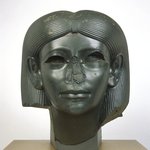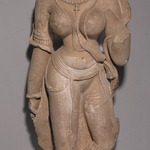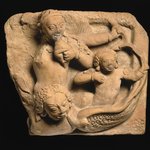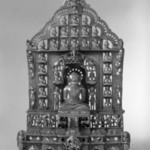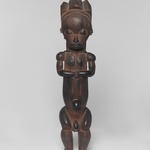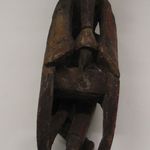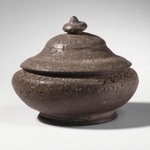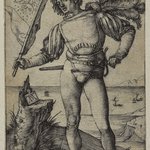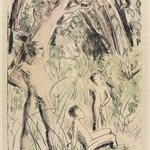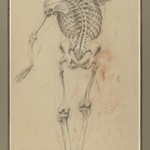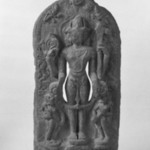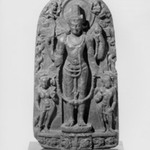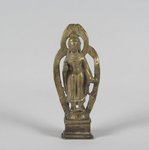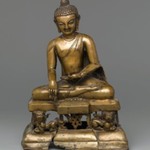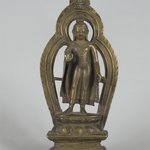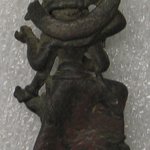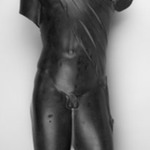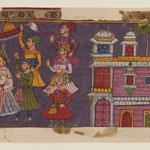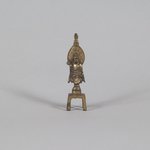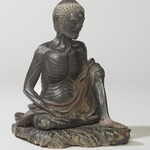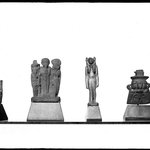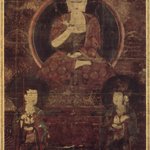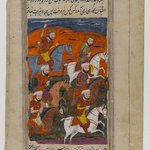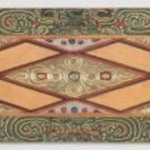
Brahmanical Triad
Asian Art
On View: Asian Galleries, Arts of South Asia, 2nd floor
The Hindu gods Brahma and Vishnu are depicted here flanking the god Shiva, who appears in the form of the lingam, his phallic emblem. The placement of the Shiva lingam in the center emphasizes the god’s importance. Shiva is a quintessentially masculine deity, symbolizing physical power, energy, and self-discipline. Despite Shiva’s defining role as Destroyer, however, he is also a physically powerful progenitor; the phallic symbol represents his ability to “inseminate” and provide the seeds for new creation. It is believed that the lingam offers a more evocative emblem of Shiva’s power than a figural representation of him could because human qualities would limit the viewer’s understanding of the god’s abstract yet generative potency.
MEDIUM
Chlorite
DATES
early 8th century
DIMENSIONS
7 5/16 × 6 5/16 × 2 3/8 in. (18.5 × 16 × 6 cm) (show scale)
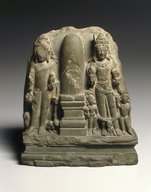


COLLECTIONS
Asian Art
ACCESSION NUMBER
78.209
CREDIT LINE
A. Augustus Healy Fund and Asian Art Acquisition Fund
PROVENANCE
Prior to 1973, provenance not yet documented; by 1973, acquired by Mr. and Mrs. Cedric Marks of New York, NY; between 1973 and 1978, acquired from Mr. and Mrs. Cedric Marks by Peter Marks of New York, NY; 1978, purchased from Peter Marks by the Brooklyn Museum.
Provenance FAQ
CATALOGUE DESCRIPTION
Brahma and Vishnu with personified attributes flank Shiva in lingam form. Brahma, Vishnu and Shiva constitute the principle deities of Brahmanism. Traditionally, Brahma is considered to be the Creator, Vishnu the Preserver, and Shiva the Destroyer. Here, at left, the four-armed Brahma is shown as an ascetic Brahmin priest with matted locks and large hoop earrings, wearing monastic robes and carrying a staff and water pot in his left hands. Two geese are shown at his feet. At the center is a lingam, the phallic symbol of Shiva. To the right, stands four-armed Vishnu, accompanied by his personified attributes: the female to the right symbolizing the mace and the male to this left representing the wheel of law. He also carries the conch and lotus in his upper hands. A miniscule image of an earth goddess is shown between his feet.
Condition: The surface is abraded along the edges of the relief, but generally it remains in fine condition. The face of the left figure and his two left hands are void and the front of the lingam is rubbed. The top of the relief has been worn unevenly as is the base on which the deities stand, but there are no recent breaks or abrasions.
EXHIBITIONS
MUSEUM LOCATION
This item is on view in Asian Galleries, Arts of South Asia, 2nd floor
CAPTION
Brahmanical Triad, early 8th century. Chlorite, 7 5/16 × 6 5/16 × 2 3/8 in. (18.5 × 16 × 6 cm). Brooklyn Museum, A. Augustus Healy Fund and Asian Art Acquisition Fund, 78.209. Creative Commons-BY (Photo: Brooklyn Museum, 78.209_SL1.jpg)
IMAGE
overall, 78.209_SL1.jpg. Brooklyn Museum photograph
"CUR" at the beginning of an image file name means that the image was created by a curatorial staff member. These study images may be digital point-and-shoot photographs, when we don\'t yet have high-quality studio photography, or they may be scans of older negatives, slides, or photographic prints, providing historical documentation of the object.
RIGHTS STATEMENT
Creative Commons-BY
You may download and use Brooklyn Museum images of this three-dimensional work in accordance with a Creative Commons license. Fair use, as understood under the United States Copyright Act, may also apply.
Please include caption information from this page and credit the Brooklyn Museum. If you need a high resolution file, please fill out our online application form (charges apply).
For further information about copyright, we recommend resources at the United States Library of Congress, Cornell University, Copyright and Cultural Institutions: Guidelines for U.S. Libraries, Archives, and Museums, and Copyright Watch.
For more information about the Museum's rights project, including how rights types are assigned, please see our blog posts on copyright.
If you have any information regarding this work and rights to it, please contact copyright@brooklynmuseum.org.
RECORD COMPLETENESS
Not every record you will find here is complete. More information is available for some works than for others, and some entries have been updated more recently. Records are frequently reviewed and revised, and we welcome any additional information you might have.

